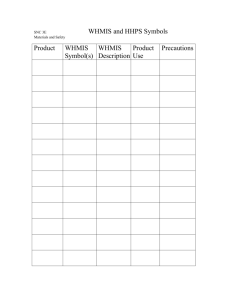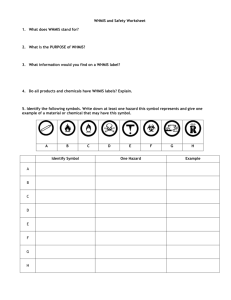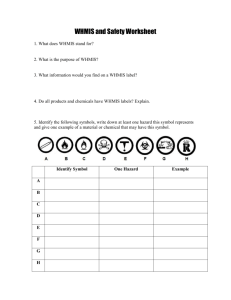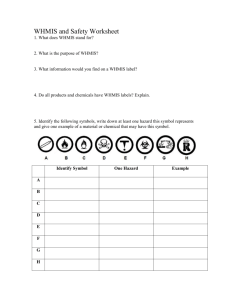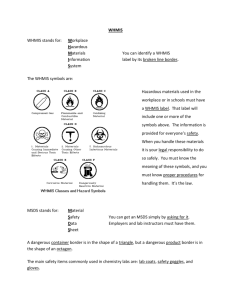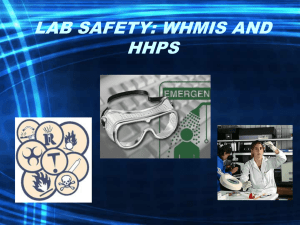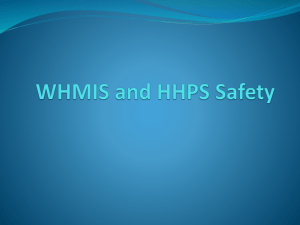File - Health and Careers 8
advertisement
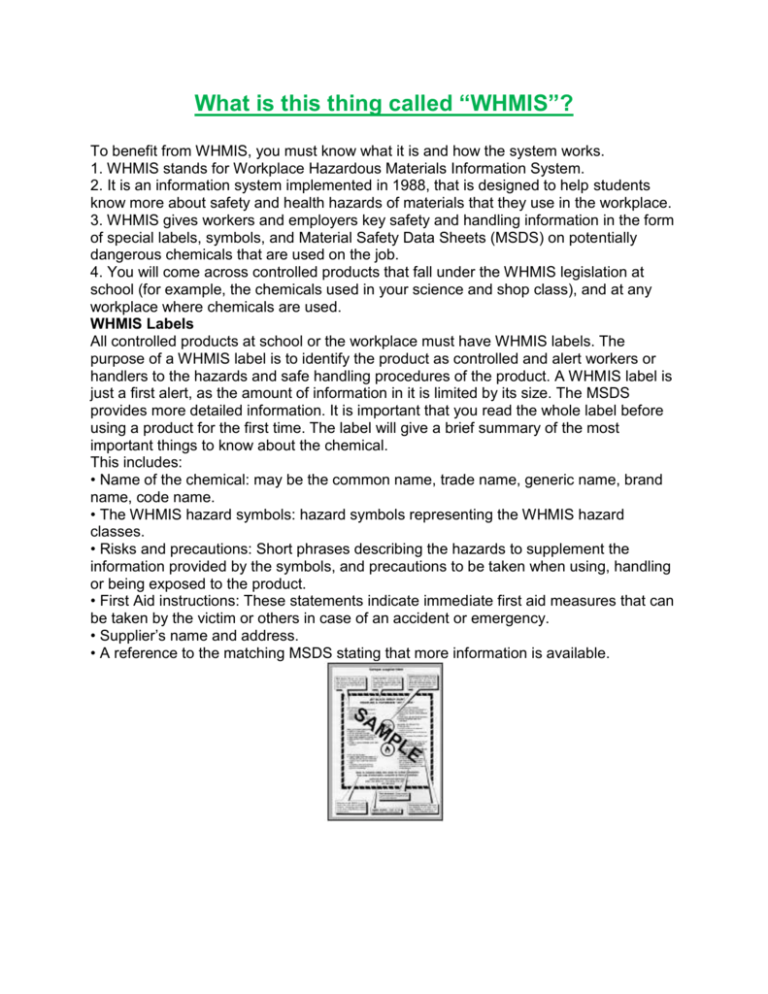
What is this thing called “WHMIS”? To benefit from WHMIS, you must know what it is and how the system works. 1. WHMIS stands for Workplace Hazardous Materials Information System. 2. It is an information system implemented in 1988, that is designed to help students know more about safety and health hazards of materials that they use in the workplace. 3. WHMIS gives workers and employers key safety and handling information in the form of special labels, symbols, and Material Safety Data Sheets (MSDS) on potentially dangerous chemicals that are used on the job. 4. You will come across controlled products that fall under the WHMIS legislation at school (for example, the chemicals used in your science and shop class), and at any workplace where chemicals are used. WHMIS Labels All controlled products at school or the workplace must have WHMIS labels. The purpose of a WHMIS label is to identify the product as controlled and alert workers or handlers to the hazards and safe handling procedures of the product. A WHMIS label is just a first alert, as the amount of information in it is limited by its size. The MSDS provides more detailed information. It is important that you read the whole label before using a product for the first time. The label will give a brief summary of the most important things to know about the chemical. This includes: • Name of the chemical: may be the common name, trade name, generic name, brand name, code name. • The WHMIS hazard symbols: hazard symbols representing the WHMIS hazard classes. • Risks and precautions: Short phrases describing the hazards to supplement the information provided by the symbols, and precautions to be taken when using, handling or being exposed to the product. • First Aid instructions: These statements indicate immediate first aid measures that can be taken by the victim or others in case of an accident or emergency. • Supplier’s name and address. • A reference to the matching MSDS stating that more information is available. WHMIS Symbols The shapes of the symbols used on labels have been chosen to show the nature of the hazard they represent. Class A Class B Class C COMPRESSED GAS • It is a gas kept under pressure. • Heat may cause the container to explode. • A drop or impact may cause the container to explode. E.g. steel cylinders of acetylene, oxygen, hydrogen, helium, chlorine, nitrogen, neon, argon etc. and fire extinguishers. • Compressed gases can be hazardous simply because they are under high pressure, and the gas itself can also be hazardous (like chlorine gas). If the gas itself is hazardous, it will have other appropriate hazard symbols along with the compressed gas symbol. • Handle with care, do not drop. • Keep away from heat or potential sources of ignition. Store in a designated area. Large cylinders must be properly secured with a chain. FLAMMABLE AND COMBUSTABLE MATERIALS • The material is a potential fire hazard. It may burn at relatively low temperature. Sparks, flame or friction could ignite it. • May burst into flame spontaneously in air or release a flammable gas on contact with water. • Keep any of these materials away from heat sources and other combustible materials. Never smoke when working with or near the materials. Store in a cool, fire-proof area. Division 1: Flammable Gases: E.g. hydrogen, methane, propane. Division 2: Flammable Liquids Flashpoint less than 37ºC. These liquids catch on fire easily and have highly flammable fumes. E.g. gasoline, ethanol, methanol, diethyl ether. Division 3: Combustible Liquids: Flashpoint > 37ºC E.g. diesel fuel, kerosene. These are less easily ignited than flammable liquids. Division 4: Flammable Solids: E.g. magnesium, sodium, beryllium. Division 5: Flammable Aerosols: E.g. most aerosol cans contain flammable propellants, also butane, propane in aerosol containers. Division 6: Flammable Reactive Materials: Materials that could spontaneously ignite in air (celluloid, lithium aluminum hydride) or in water (sodium). Oxidizing Materials The material is a fire or explosion risk near flammable or combustible material. May burn skin or eyes on contact. • An oxidizing material may or may not burn itself, but will release oxygen or another oxidizing substance, and thereby causes or helps a flammable or combustible material to burn. E.g. sulfuric acid, perchloric acid, hydrogen peroxide, sodium peroxide, benzyl peroxide, permanganates, dichromates, perchlorates, chlorine and bleach. • Keep the material away from combustible materials and store in designated areas. Keep the material away from sources of ignition. Never smoke when working near the material. • Wear proper protective equipment, including eye, face and hand protection and protective clothing. Class D Class E Class F POISONOUS AND INFECTIOUS MATERIAL • The material is a potentially fatal poisonous substance. It may be fatal or cause permanent damage if it is inhaled, swallowed or absorbed through skin. May burn skin or eyes on contact. Division 1: Materials Causing Immediate and Serious Toxic Effects. • These materials are immediately dangerous to life and health. They can kill you fast! • Handle the material with extreme caution. Avoid contact with the skin or eyes, use proper protective clothing. • Avoid inhaling by working in well-ventilated areas. Wear respiratory equipment. • Wash and shower thoroughly after using. • Store in designated areas only. Division 2: Materials Causing Other Toxic Effects • The material is poisonous but not immediately dangerous to health. It may cause death or permanent damage as a result of repeated exposure over time. Usually the effects result from repeated exposure to the substance in the workplace over a long period of time. E.g. repeated exposure to benzene, asbestos. • Includes materials that can cause immediate irritation (to the eyes, skin, or lungs). Includes materials that can cause ill health effects that are not immediate; such as allergies, asthma, cancer, organ damage, birth defects, sterility, or other serious illness or disease. • Avoid skin and eye contact by wearing all protective equipment necessary including eye, face and hand protection and protective clothing. • Avoid inhaling by working in well-ventilated areas. Use respiratory equipment. • Store in designated areas. Division 3: Biohazardous Infectious material. This includes organisms (like bacteria and viruses) and the toxins they may produce that are believed to cause disease. E.g. anthrax (in meat handling), salmonella, hepatitis B virus, AIDS virus, certain fungi and moulds, contaminated blood and pathogenic bacteria cultures, etc. CORROSIVE MATERIAL • Caustic or acid materials that can eat through the skin or corrode metals like aluminum or steel. E.g. chromic acid, sulfuric acid, nitric acid, sodium hydroxide, hydrofluoric acid, some household cleaners, water treatment chemicals, photographic chemicals, lye. • This class also includes corrosive gases such as ammonia and the acids hydrogen fluoride, hydrogen chloride, hydrogen iodide and hydrogen bromide. DANGEROUSLY REACTIVE MATERIAL • Products which undergo dangerous reactions (such as polymerization, decomposition or condensation), when subjected to heat, pressure, shock or contact with water. Examples: • Plastic monomers such as butadiene undergo hazardous selfpolymerization unless inhibitors are added, • Copper and mercury acydes, acetylides, ether, peroxides,benzyl peroxide, picric acid and isopropyl nitrates can be explosive under shock. • Calcium carbide reacts with water to release acetylene gas. International Hazard Symbols • Not all products are controlled by the WHMIS legislation, and so they may not have WHMIS labels or use the exact same symbols as WHMIS. You’ll see these other symbols on products you commonly find around the house and garden, including cosmetics (like hairsprays), pesticides, and some consumer and household products (like oven cleaners). These products use the International Hazard Symbols you see below. • For your safety, you should be able to recognize these symbols and understand what hazards they represent. • The following warning symbols used on labels are not controlled by WHMIS legislation: Note: The border that surrounds each symbol signifies the danger level of the hazard. • An octagon (same shape as a stop sign) indicates “ DANGER“ and represents the most dangerous hazard. • A four-sided diamond, indicates “WARNING“ and represents a moderate or medium hazard level. A warning diamond does not pose as extreme a risk as the danger octagon. • The upside-down triangle indicates “CAUTION” and represents the slightest or least hazard of the three borders. This does not make it hazardless! Use these products with caution.
